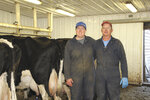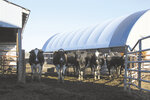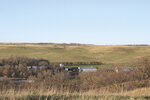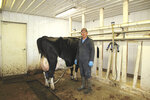



ST. CHARLES, S.D. — In the southcentral part of South Dakota, 2 miles from the Nebraska border, sits what has become a rarity in those parts: a dairy farm.
Owned by the Jons family, it is the only remaining dairy farm in Gregory County and the last one in the state west of the Missouri River. Yet, the Jonses hope to hold on into the fourth generation.
“We have no plans of packing up and moving,” said Verlyn Jons, who operates the farm with his wife, Dana.
The Jonses milk 29 Holsteins in a 10-stanchion barn with a pipeline. In the past, they have milked 45-60 cows, but they decreased the herd due to drought.
“We milk in an old half-circle Quonset barn with a milk room and parlor in it,” Jons said.
“We also have a hoop shelter with a loafing area and a feeding area. During spring and summer, the cows graze.”
Besides two hoop buildings, the farm has pole barns for equipment storage.
The only other dairy farm in the area is in Boyd County, Nebraska, which abuts Gregory County.
The Jonses’ sons, Andrew and Matthew, are interested in joining the family’s farming operation. Both attend the technical college in Mitchell and come home on weekends. Most days, since the Jonses have no employees, Jons and Dana work to do the milking twice each day along with other farm chores.
“We have our tasks, and it’s good to be milking together,” Jons said. “We get our chores done pretty quickly that way.”
The Jonses grow crops for feed on 150 acres. They also raise 35 beef cow-calf. The dairy farm, where Jons grew up, is in an isolated spot, 4 miles off the highway.
“It’s a picture place with hills and valleys and trees, and we’ve got live streams that run through the land,” Jons said. “We don’t have a lot of crop ground because we have mostly small fields, and it’s mainly pasture that we run our beef cows and dairy animals on. It can be somewhat nasty in the winter with gravel roads and hills, so it’s a little treacherous for the milk truck to get in at times.”
Jons’ grandfather purchased the dairy farm in 1926, and Jons’ parents took over in the early 1950s.
“With my 13 siblings, we all had to do our share while growing up,” Jons said. “When we all graduated and went off to college, everybody found other careers. When I graduated from college in 1985, I came back to help and just kind of stayed with it.”
Through their years of farming, the Jons couple watched as the remaining dairies in their area disappeared.
“It seemed like everybody milked cows when I was a kid,” Jons said. “This county had the largest number of dairies in the state. For being out here in the middle of nowhere, there were a lot of dairies.”
Jons said the push for dairy farms to get bigger in the 1990s had an effect on his county.
“There used to be all the neighbors milking cows, and then slowly, people started quitting,” he said. “We used to have a dairy inspector whose line was, ‘If you’re not milking a lot of cows, you’re not serious about dairying, and if you’re not serious about dairying, you can’t be doing a good job.’ They wanted to get rid of a lot of us little guys.”
The scenery in Gregory County began to change.
“It used to be that everyone had Holsteins out on pasture, but you don’t see Holsteins anymore,” Jons said. “We’re the only ones now who have them on a pasture.”
With the declining dairy farm numbers and growing herd sizes in the eastern part of the state, it became a challenge for them to get their milk picked up, something they are wrestling with today.
Recently, the plant in Freeman — a distance of about 110 miles — could no longer take their milk, so it is going to a processor in Le Mars, Iowa, located 171 miles away.
Another challenge has been limits placed on how much milk the Jonses can sell.
“With their supply management system, we can’t get any bigger,” Jons said. “They came up with their quota system — their base access program — last year, so we can’t get any bigger. We had cut our herd down because of the drought, but now (processors) go off of that base, so we can’t expand.”
The Jonses would like to find a dependable way to continue dairy farming.
“The boys would like to try to figure a way to have on-farm processing if the local area would be able to support that,” Jons said. “Right now, our hauling is $1.80 per hundredweight. When we get a milk check, we look at the low milk price and take about $2 off that milk price; it kind of stinks.”
On-farm processing would also allow for keeping a small herd and making a profit despite milk prices being low.
“That would be the ideal thing,” Jons said.
In the meantime, the family holds on by streamlining their operation.
“We always try to get more efficient and make a go of it,” Jons said. “Most of our calving is done in August and September so that all our heifers are the same age and we have one group to feed.”
The Jonses also focus on milk quality.
“We have to shoot for higher components because of the (cost of) shipping of our milk,” Jons said. “We genomic test our heifers and select for components. We’re steering more toward A2A2.”
With the future uncertain, Jons said he hopes his family can hold on to the lifestyle they love.
“It’s a lot of work, seven days a week,” Jons said. “But, then other people don’t get to witness the births of baby calves and watch those calves grow up and become a part of the herd.”
After milking cows for over 40 years, Jons said it is his favorite task.
“All our cows have their own nature, and they are as gentle as you can get,” Jons said. “When you’re milking in a stanchion barn, you’re right there next to them, and you let them in and out. They greet you when they come in and greet you when they leave.”
Comments
No comments on this item Please log in to comment by clicking here